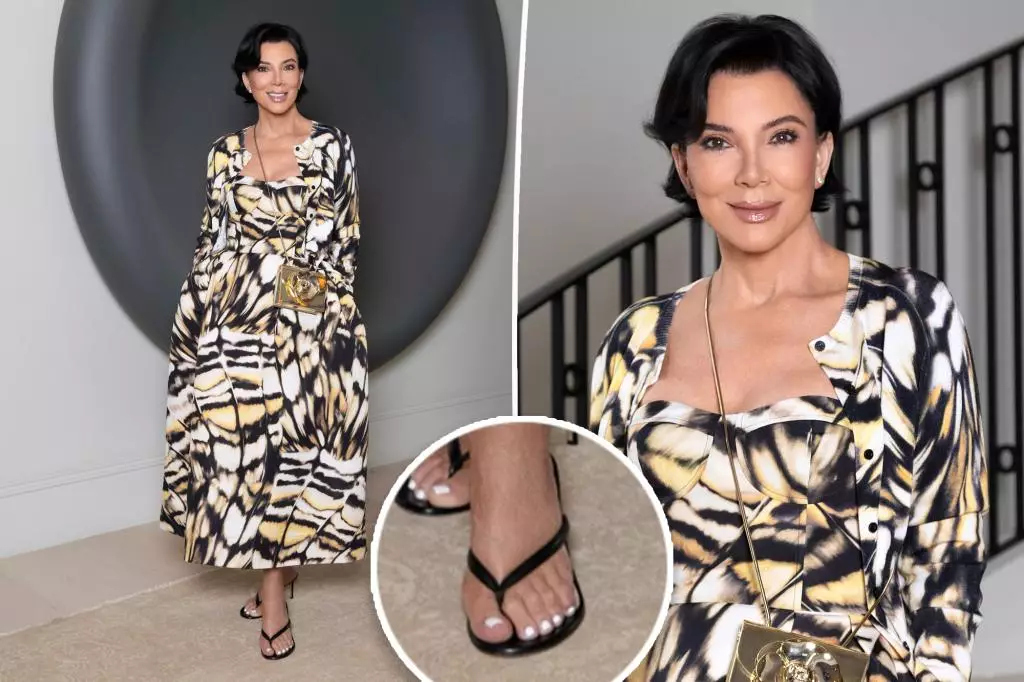In an era dominated by social media, celebrities are under relentless scrutiny to perpetuate images of flawlessness. Despite their polished facades, subtle imperfections and digital manipulations often seep through the meticulously curated content. Recently, Kris Jenner’s Instagram post from her mother’s 91st birthday surfaced, shedding light on this phenomenon. The online community quickly pointed out what appeared to be a Photoshop mishap—an extra toe peeking from her sandal, igniting a wave of comments that oscillated between critique and amusement. What this reveals is not just an error but a reflection of the pervasive obsession with perfection that celebrities uphold and the sometimes apparent human slip-ups that expose their vulnerabilities.
This incident taps into the broader narrative of self-image in entertainment culture. The desire to appear eternally youthful and impeccable leads many to manipulate images, often to the point of absurdity. It raises questions about authenticity and the societal pressures placed on public figures to craft an idealized version of themselves. Yet, it also highlights a critical aspect: imperfection, even among icons, is inevitable. Sometimes, these digital bloopers humanize the stars, breaking the illusion that they are immune to faults, yet the relentless pursuit of flawlessness continues to define their visual narratives.
The Double-Edged Sword of Social Media Manipulation
Perhaps more compelling than individual slips are the recurring patterns of Photoshop fails in the Kardashian-Jenner universe. For years, the family has been accused of distorting images—whether it’s Kim’s leg allegedly edited in a bikini photo or Kylie and Kim’s toes mysteriously multiplying in promotional images. These blunders have become almost a signature of sorts, exposing the tension between image perfection and reality.
Kim Kardashian’s admission about the Disneyland photo, where she swapped her niece’s face onto another child’s body, exemplifies the lengths to which celebrities go to maintain a certain aesthetic. While her honesty reveals a more relatable side, it also emphasizes the omnipresent pressure to present an idealized version of life, sometimes at the expense of authenticity. The frequency of these digital misadventures suggests a culture of complicit concealment and the importance placed on appearance over reality. As audiences become more skeptical and more aware of digital manipulations, this obsession with perfection may backfire, fostering suspicion rather than admiration.
However, it’s vital to recognize that this pattern cuts both ways. These missteps can serve as a wake-up call—a reminder that even those at the peak of superficial beauty are imperfect and vulnerable. Yet, instead of humanizing, such errors often ignite more criticism, fueling a cycle where celebrity images are scrutinized to the point of obsession, often overshadowing their achievements or authentic selves.
The Cultural Implications of Image Manipulation
Beyond the personal vanity or technical errors lies a deeper cultural dilemma: our collective obsession with appearance and youth. For celebrities like Kris Jenner, defying aging has become a core aspect of their identity and brand. The rumors of her looking “younger” in photos reinforce this phenomenon—an industry obsession with eternal youth that filters down into public consciousness.
This fixation has broader implications: it influences societal standards, shaping perceptions of beauty that are often unattainable. The legend of flawlessness perpetuated by celebrities creates a damaging narrative that authenticity is a liability. That illusion fosters a culture where digital tweaks are accepted, if not expected, and natural aging is often shunned.
Yet, ironically, these digital misadventures also open a window to authenticity. They remind us that behind the glossy veneer, celebrities and public figures are just human—subject to error, age, and imperfection. The more they attempt to erase these natural facets through Photoshop and cosmetic procedures, the more glaring their human vulnerabilities become when mistakes come to light. Perhaps, in this paradox, lies an opportunity: embracing authenticity over contrived perfection might ultimately foster a healthier relationship with self-image for both celebrities and fans.
As we continue to scrutinize and dissect every digital detail of our idol’s lives, it becomes clear that the pursuit of perfection is both an obsession and a façade. Imperfections—be they a sixth toe or a Photoshopped leg—serve as subtle reminders that beneath the veneer of glamour lies human imperfection. The challenge lies not in erasing these faults but in accepting their existence in a culture increasingly obsessed with superficial flawlessness.

